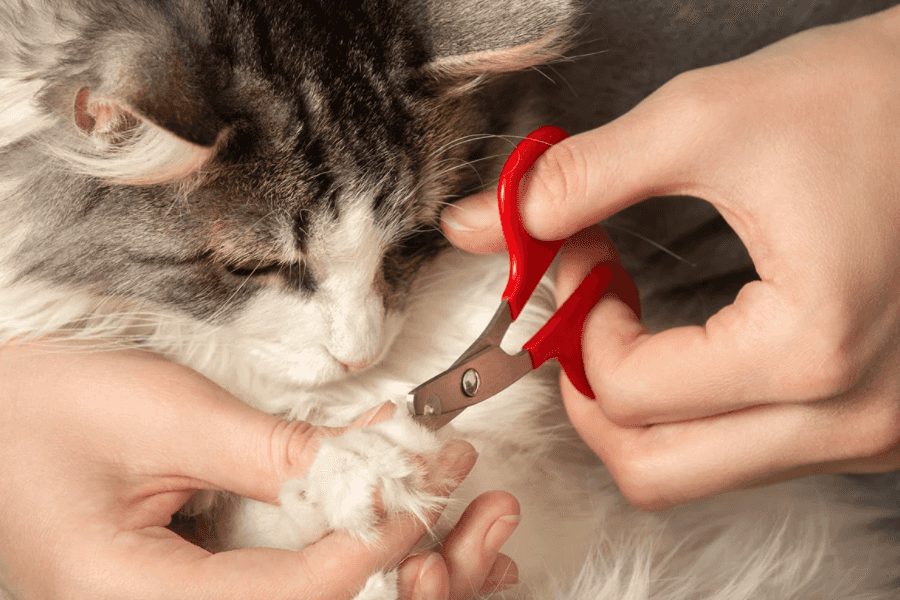Do You Need To Trim Cat Nails? Yes Or No

Trimming your cat’s nails is a common question that cat owners have. Those sharp claws can definitely do some damage if they get too long. But is it absolutely necessary for all cat owners to trim their cat’s nails regularly? The short answer is: it depends. ![]()
There are a few factors to consider when deciding if and how often nail trims are needed for your feline companion:
Why Cats Have Nails

Cats’ retractable claws serve important purposes in their lives:
Hunting and capturing prey - The sharp pointed claws help cats grip onto slippery prey like mice and birds.
Climbing and balancing - Claws give cats traction and gripping ability when navigating up trees or precarious ledges. The dewclaw on the inner side of the front paws in particular aids climbing.
Defense - Those claws come in handy for swatting at predators or enemies in order to escape danger.
Marking territory - When cats scratch objects, they leave behind pheromones from glands in their paw pads. This marks their turf.
Sharpening - Scratching also helps cats condition and sharpen the claws by sloughing off old nail sheaths.
So in short, claws are a vital tool for survival and instinctual cat behavior.
When Are Nail Trims Necessary?

Whether your cat needs nail trims depends on several factors:
Indoor vs. Outdoor Lifestyle
Outdoor cats will usually wear down their claws naturally through daily activities - climbing, scratching, etc. Trimming is often not needed.
However, indoor cats have fewer opportunities to condition their claws. Without sufficient scratching, their nails can overgrow.
That’s why most indoor cats need occasional nail trims, about every 2-4 weeks. Providing adequate scratching posts can help reduce the frequency though.
Age
Kittens and younger cats are more active and often good about using scratching posts. Thus they may only need occasional nail care.
Senior cats become less active as they age. Their nails may overgrow if the cat can no longer scratch effectively. More frequent trimming may be required, perhaps every 10-14 days.
Health Issues
Cats with arthritis or other conditions limiting activity may also need more nail care if they cannot scratch normally.
Overgrown nails can also cause ambulation problems making it painful to walk. In this case, trimming provides relief.
Nail Condition
Some cats simply have fast growing nails that require more frequent trims than average.
Thick or brittle nails in older cats may need care to avoid cracking and splitting.
If you notice curled nails growing into the paw pads, it’s definitely time for a trim to relieve irritation.
How to Trim Your Cat’s Nails

If you determine your cat needs nail trims, follow these tips for a safe, stress-free pedicure:
Get The Right Tools
Invest in a high-quality cat nail clipper. Avoid using regular human nail clippers. The proper tool will have a guillotine-style blade designed to avoid splintering nails.
Have styptic powder on hand in case you trim too close. This will stop bleeding if you nick the quick (the pink part inside the nail containing blood vessels and nerves).
Pick Your Timing Wisely
Wait until your cat is relaxed and calm. The best time is often when kitty is sleepy after a meal.
Avoid trying to trim when your cat is agitated. Rushing while they’re upset will only make things worse.
Get Your Cat Comfortable With Handling
If your cat is not used to having their paws touched, take some time to get them accustomed to it first.
Gently handle their paws and press on the pads to extend the nails for just a few seconds, then reward with treats. Do this in short sessions until your cat is comfortable.
Take It Slowly
When ready to actually trim nails, only do one or two per session at first. Don’t attempt to do all of them at once. Go at your cat’s pace.
Make sure to reward good behavior with treats and praise so your cat has positive associations.
Know Where to Cut
Identify the pink quick inside the nail and avoid cutting it. Only trim the sharp tip of the translucent area. Cutting a little at a time is safer.
The dewclaws on the inner front paws also need occasional trimming. Take care, as these are harder to see.
Stop If Your Cat Gets Upset
Never restrain or punish your cat during nail trims. If kitty begins resisting or getting agitated, stop for the day and try again later. Forcing it will only cause trauma.
Are Nail Trims Cruel?

Some people view trimming a cat’s nails as inhumane and unnecessary. There are a few things to note regarding the ethical considerations:
Declawing cats (surgically removing the nails entirely) is certainly cruel and should never be done simply for the owner’s convenience. However, careful nail trimming is vastly different and does not typically cause the cat pain when done properly.
For indoor cats, providing scratching posts AND occasional trimming is the compassionate choice to keep nails healthy. Proper nail care prevents issues that would cause the cat discomfort down the road.
Trimming should only be done as needed for the individual cat. It should never be forced on a cat that shows signs of aggression or high stress during the process. As described above, have patience and work within the cat’s limits.
Nail trims should not be viewed as “punishment” for destructive scratching. Instead, ensure you are meeting all of your cat’s needs for physical activity, appropriate scratching outlets, and mental stimulation. Then integrate gentle nail care as part of a regular health routine.
Talk to Your Vet
If you are unsure about your cat’s specific nail care needs, schedule a checkup with your veterinarian. They can examine your cat’s lifestyle, activity level, health issues, and current nail condition in order to make an informed recommendation.
The vet can also demonstrate proper nail trimming technique and tips for acclimating your cat to the process.
Alternatives to Nail Trimming

If your cat absolutely will not tolerate nail trims, speak to your vet about alternatives:
Nail caps - These plastic caps glue onto the nails to blunt the sharp tips. They fall off as the nail grows and need to be replaced about every 4-6 weeks.
More scratching posts - Providing ample surfaces and textures for scratching may help wear down nails enough to avoid trimming.
Cat-friendly nail filers - Rubbing the sharp tips down with an emery board is less invasive than clipping.
Ask your vet/groomer - They can trim nails quickly and humanely if your cat behaves better for professionals. Some vets may prescribe a mild sedative.
Conclusion

While clipping your cat’s nails may seem intimidating at first, it is a simple way to keep your feline friend comfortable and prevent problems.
For most indoor cats, occasional nail trims are recommended as part of a regular grooming routine. However, each cat is unique. Take your individual pet’s lifestyle, health, and stress levels into consideration. Work patiently within their tolerance levels.
Consult your veterinarian if you need guidance on determining if and how often your cat needs nail care. With the right approach, trims can be quick, painless, and keep those claws from accidentally tearing up more than just the scratching post!
Tags
Share
Table Of Contents
Related Posts
Quick Links

